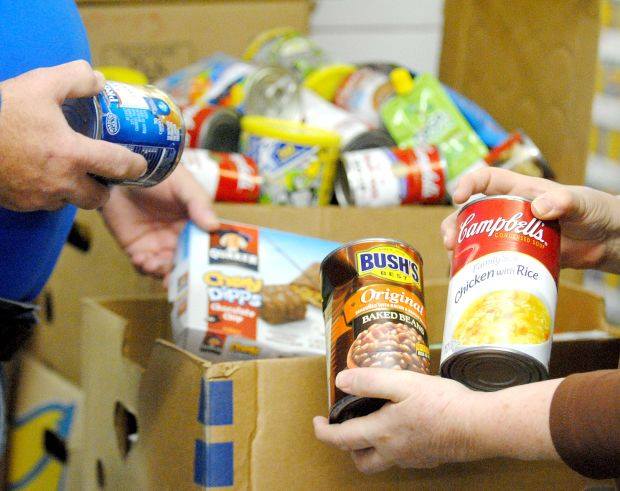Of the many social issues a living wage addresses, food insecurity is one of the most common among people with low income. Broadly defined as the lack of regular access to affordable, healthy and culturally appropriate food, food insecurity impacts at least 15.1 per cent of Niagara residents and 19.2 per cent of Ontarians as of the 2021 census.

While many factors contribute to food insecurity, such as the lack of immediate access to food, a lack of cultural presence in a region, and skyrocketing food prices, they all share a common denominator: poverty and financial instability.
To better understand how all these factors are connected, we spoke with Chandra Hardeen, United Way Niagara’s Director of Community Investment, on food security in Niagara. The portrait she painted for us was clear: “Poverty and food insecurity are interconnected issues,” said Hardeen. “Having less income can lead to having to choose between putting food on the table or prioritizing other essentials in your budget.”
The first, and perhaps most apparent, impact of poverty on food insecurity is the inability to afford appropriate food -this has been exacerbated by the drastic increase in prices at the grocery store - in some cases prices have risen by as much as 17 per cent. Meanwhile, wages, particularly minimum wages, have not increased comparably. The Ontario minimum wage, for example, is being raised to $16.65 per hour in October 2023, an increase of approximately 7 per cent. While this increase is in keeping with the average annual inflation rates since the beginning of the COVID-19 pandemic, it still falls well short of even the most conservative estimates for grocery cost increases.
This financial shortfall is also reflected in the number of people who report being food insecure. The most recent Canadian census was recorded in 2021, at the height of the pandemic, when many Canadians were still receiving government benefits. Hardeen suggests that it was likely these benefits lessened the burden of food costs on many Canadians, and that the number of food-insecure Canadians has likely increased dramatically since benefit programs ended.
To make matters worse Hardeen says that in terms of basic needs, food is often perceived as a more “flexible” need than others. Frequently, when faced with a choice between food and fixed expenses, many experiencing poverty will forgo groceries in favour of making payments toward less flexible necessities like housing or utilities. While choosing to skip meals can have negative health impacts, for many, the choice between a few days of feeling hungry or risking eviction is no choice at all.
Unfortunately, the impact of poverty on food accessibility extends far beyond the simple unaffordability at the grocery store. Poverty prevents many people from moving or finding affordable housing, impacting their access to healthy, culturally appropriate food. One issue Hardeen noted in our discussion was the presence of food deserts, as well as food swamps, in many Canadian cities. Individuals living in food deserts and swamps often have to travel outside of their neighbourhoods to access the food they need, which means increased travel costs for transit users and those with access to a personal vehicle.
While travel outside of one’s neighbourhood may not seem like an issue at all, we have to consider additional demographic factors that may make accessibility more difficult, and which often go hand-in-hand with poverty. Mobility issues, for example, may limit a person’s ability to travel for shopping, how much they can afford to spend, or even which stores they can shop in. Additionally, certain cultural foods may not be available in some neighbourhoods, imposing further travel expenses.
Public transit can also make regular shopping trips a long, costly ordeal; residents may have to rely on more expensive alternatives like taxis or rideshare services for regular trips. Living in close proximity to amenities would be the ideal solution, but astronomical rents, and an overall lack of available units mean this is not an attainable reality for most.
Even current solutions are impacted by these issues. While several government organizations and nonprofits like United Way are working to address food insecurity, these programs cannot solve the problem on their own. Food programs, pop-up markets, and government assistance programs are all crucial resources for addressing food insecurity. Food programs help thousands of struggling families get enough to eat every month, but despite their good work, poverty remains a persistent issue. Many organizations are also dependent on donations and sponsorships, and as food insecurity increases across Canada, may struggle to keep pace with people’s needs.
Often, those with reliable income are still in need of assistance, as single, working adults made up 45 per cent of food bank visitors in Ontario in 2022. Hardeen also noted that many who rely on food programs struggle with the perceived cultural stigma of relying on assistance to make ends meet. Pop-up markets are one solution for dealing with this issue, as they require a minimum level of payment in exchange for goods, but they are not always a steady or reliable means of buying groceries. As with many food programs, pop-up markets are just one aspect of a larger solution to the problem of food insecurity.
This is where the living wage comes in. As we’ve mentioned before, a living wage is a tool designed specifically to address poverty at the source, and provide families with the necessary income to ensure a comfortable, healthy lifestyle. Food pricing is one of several factors used to calculate a region’s living wage, so the living wage will at least partially reflect the realistic cost of feeding oneself and one’s family. When businesses offer a living wage to their employees, they’re doing more than just providing a simple pay raise. They’re making sure those employees won’t have to worry about where their family’s next meal is coming from, and helping those families stay healthy, happy, and active in their communities.

